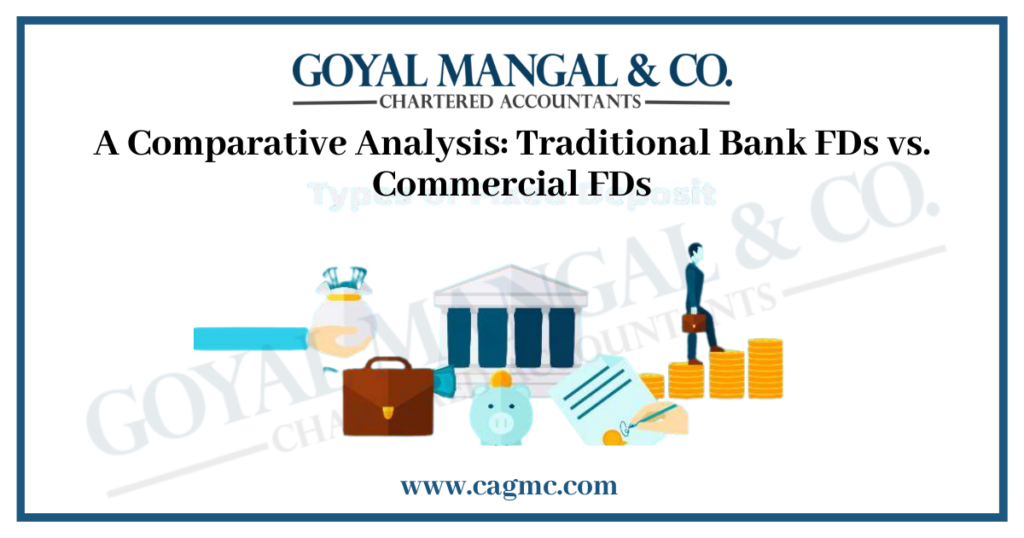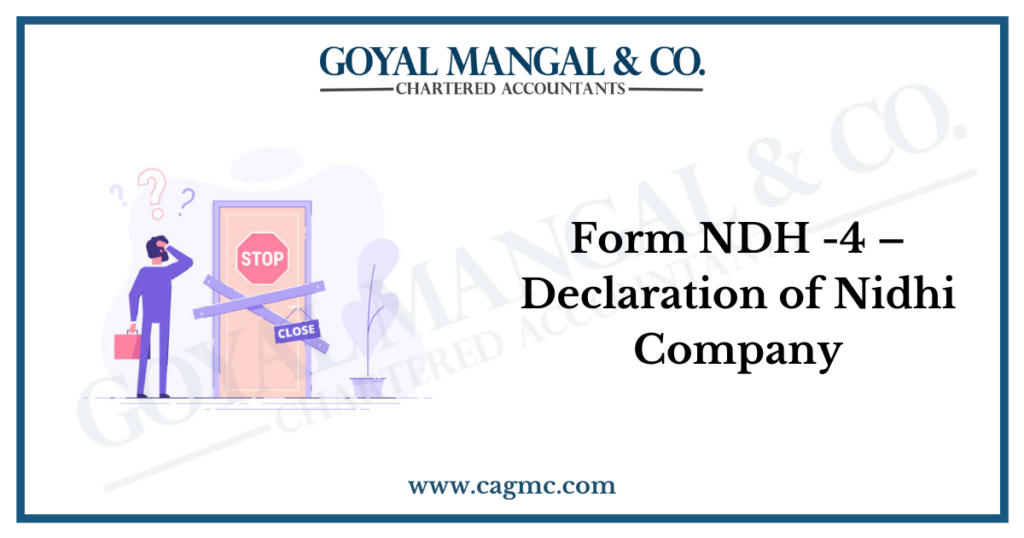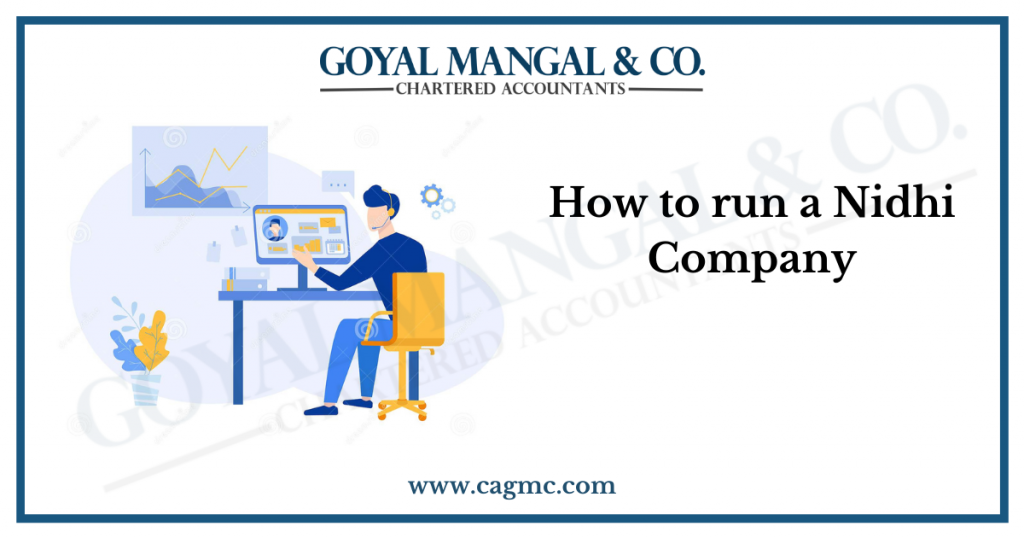
Fixed deposits are the best strategy to save. It offers set interest and returns. All major banks offer it. India has historically preferred fixed deposits for saving and investing. FDs have been for years a secure, trustworthy, and trendy way for normal people to save and invest. But how do you know which is the best FD option for you? Fixed Deposits can be of different types, however in this article we will learn all about the differences between a traditional bank’s FD and a commercial bank’s FD i.e., Traditional Bank FDs vs. Commercial FDs, as well as their meaning, benefits, and comparison.
Meaning of Fixed Deposit
A fixed deposit, often known as an FD, is a type of investment that use to aid clients’ money-saving abilities and is used by banks and other types of financial institutions (NBFCs) to assist their customers in saving money. Since Fixed Deposit accounts have a predetermined interest rate and can be paid back over a specific time, often spanning up to 5 years, they are more liquid than other types of investments.
Should you invest in one big FD or multiple smaller FDs?
To eliminate default risk, minimize FD exposure of more than Rs 5 lakh in a single bank. The best strategy to invest is in many FDs, ideally in different banks, with a maximum deposit of Rs 5 lakh per bank. Having many FDs lets you liquidate one or two for emergencies without affecting the rest.
If you maintain the entire amount in a single FD, you may have to liquidate it early in a financial crisis after losing a percentage of the interest income in penalties.
However, one large FD has advantages. You don’t need to track multiple FD investments’ maturities and reinvestment dates. Thus, you can choose based on safety and convenience.
Is it best to wait for FDs to mature or its better cash them out early?
Breaking FDs is risky, especially if interest rates are predicted to fall. When you invest again, you may not obtain the same interest if you break an FD. After understanding the terms and restrictions, you may choose an overdraft (OD) arrangement against your FD to satisfy your short-term needs without penalty.
If your liquidity crunch is projected to last and interest rates are expected to rise, you may prematurely break your FD to fulfil your financial needs and invest in a higher-interest FD as soon as possible. This selection should also be based on the availability of loan options that match your needs and the comparison of the loan interest rate with the FD rate after deducting the early withdrawal penalty.
FD returns are fully taxed at the investor’s income tax slab rate. Consider post-tax FD returns before deciding. However, if your FD is near maturity, you may want to avoid breaking it and find alternative ways to meet the requirement.
Meaning of Bank Fixed Deposit
Bank Deposits are short-term deposits with nationalized and private banks. Banks offer set interest rates based on the current frugality. Banks offer varied maturity options, including automatic renewal or crediting the client’s account.
Investors can also reinvest or simply withdraw the interest at defined periods. For two reasons—trust and access—Indians invest in bank fixed deposits. Bank fixed deposits are the safest investment because the banking sector is heavily regulated, and failures are rare.
Second, most people have savings accounts in bank branches across the country.
Opening a fixed deposit with the same bank branch was the easiest way to get a higher return than savings. Since interest rates are guaranteed, calculating the expected return is straightforward, reducing investor scepticism. RBI-mandated insurance covers bank fixed deposits up to 5 lakhs. Thus, fixed deposit holders are somewhat protected from bank failures.
Features of Bank Fixed Deposit
Following are the features of Bank FD:
- Bank FDs have a potential maturity of between seven days and ten years.
- Bank FDs provide returns at maturity or on a regular basis.
- Financial institutions (both privately owned and publicly owned) can offer these FDs.
- On bank FDs, the Reserve Bank of India provides security of more than INR 5 Lakh.
- Based on the conditions and the type of FD issued, bank FD serve as an investment vehicle that saves taxes.
Advantages of investing in Bank Fixed Deposit
Advantages of investing in Bank FD are:
- A bank FD often offers higher rewards than a savings account.
- Mileage loan against bank FD, depending on the issuers.
- Bank FDs provide increased security because they are backed by the Reserve Bank of India.
- Unseasonable withdrawal installation is still possible with Bank FDs, but according on the issuer’s terms, it can incur a fee.
Eligibility for Bank Fixed Deposit
The eligibility criteria may vary depending on the bank and the type of account. Here are some general eligibility criteria:
- Indian citizens
- Non-Resident Indians (NRIs)
- Hindu Undivided Family (HUF)
- Clubs, societies, associations
- Partnership firms
- Public/private limited companies/sole proprietorship
- Trusts
- Government departments
List of documents required for Bank Fixed Deposit
You will also need to furnish a few documents to start a fixed deposit account. Depending on the bank and the type of account, different documents could be needed. Documents needed include:
- Passport
- PAN card
- Voter ID card
- Driving license
- Government ID card
- Photo ration card or Senior citizen ID card
- Company PAN card
- Registration or incorporation certificates
- Bank account statement/latest telephone bill/latest electricity bill
- KYC of authorized signatories
- Board resolution for FD opening
- Passport size photographs
It is recommended to check with the bank or financial institution for a complete list of eligibility criteria and documents required for opening a fixed deposit account.
Parameters to consider before investing in Bank Fixed Deposit
Several factors should be considered before investing in a bank fixed deposit. Search results suggest these considerations:
- Bank Interest Rates: Bank interest rates are essential. Before investing, compare bank interest rates. Recently Indian Bank offered highest bank FD rates between 3.25% to 7.75% for tenure ranging from 7 days to 10 years
- Tenure: Fixed deposit tenure is another crucial aspect. Choose a bank with a duration that meets your demands. Indian Bank FDs last 7–10 years.
- Taxation: Income tax slabs apply to fixed deposit interest If fixed deposit interest surpasses Rs. 40,000 per year, TDS is 10%.
- Premature withdrawal penalty: Some banks may penalize fixed deposit withdrawals. Indian Bank charges 1% for fixed deposits over Rs. 5 lakhs withdrawn before 181 days.
- Bank safety and credibility: Choose a trustworthy and safe bank. ICICI Bank FDs are AAA-rated, the safest.
- Senior citizen benefits: Some banks provide higher interest rates for seniors.
Before investing in a bank fixed deposit, examine interest rates, term, taxation, early withdrawal penalties, bank safety and credibility, and senior citizen perks.
Meaning of Commercial Fixed Deposit
Commercial FDs are also known as Marketable FD. Commercial FDs (Fixed Deposits) refer to fixed deposits offered by commercial banks, as opposed to traditional bank FD. Commercial FDs rates offer higher interest rates than bank FDs, but they are not covered under the deposit insurance program handed by DICGC, an RBI attachment, making them less safe than bank FD.
The penalty period for early withdrawal of commercial FDs is lower compared to bank FDs, and if a customer withdraws from a commercial FD within three months of the term, they must pay a penalty The interest on commercial FDs can be compounded or paid out at maturity, depending on the customer’s preference. Customers can also avail loans against FDs up to 80 to 90 percent of the value of deposits.
Features of Commercial Fixed Deposit
Features of Commercial FD are:
- Commercial FD is AAA-rated by CRISIL, ICRA, and CARE. The highest safety to high threat of interest & top payment helps depositors judge the fiscal institution’s creditability.
- NBFCs/HFCs provide depositors various interest pay-eschewal alternatives. These include yearly daily partly monthly, and periodic pay-eschewal.
- Depositors can also choose accretive FD, which reinvested interest to demonstrate compounding. Thus, accretive options enable depositors earn more returns than non-cumulative options. Depositors can also get unseasonable pull-outs. Most HFCs and NBFCs charge public deposits a corrective rate (up to 2). Some public deposits are locked in for three months.
- Depositors can also borrow against marketable FDs in both accretive and non-cumulative FD schemes. However, some financial institutions charge 2 times the maximum fixed deposit interest rate. The depositor’s obligation pate determines marketable fixed deposit interest
- Commercial FDs are riskier than bank FDs since DICGC, an RBI appendage, does not insure them. The depositor insurance program protects accretive deposits of over Rs 5 lakh held with each listed bank in FDs opened with nationalized and private banks from adverse events like bank failures.
Documents required for Commercial Fixed Deposit
Depositors need the following documents to open a tradeable FD:
- Aadhaar Card
- Voter ID Card
- Passport
- PAN Card
- Government- validated address validation
- Colour Passport size photo
Eligibility for Commercial Fixed Deposit
Following are the eligibitly criteria for commercial bank deposits:
- Resident of India
- Members of Hindu Undivided Family (HUF)
- Partnership companies
- Corporates
- Clubs
- Educational institutions
- Cooperatives Societies
- Associations
Factors to evaluate prior to making a Commercial Fixed Deposit Investment
Commercial Fixed Deposit Investment Criteria:
- Credit ratings: ICRA, CARE, CRISIL, and others rate term deposits for reliability. Companies with AA to AAA credit ratings usually pay interest safely. Safety decreases with standing map depth.
- Existence: Investor should consider a higher-rated parent’s support in a crisis when judging the company’s financial position and market power. The Group’s longevity and corporate governance demonstrate market optimism. Strong parents reassure investors.
Interest rate: A commercial bank FD interest rates i.e., advanced interest rate is optimal. The rates are higher than bank FDs interest rates. Before deciding, compare interest rates. Some NBFCs and corporations offer higher interest rates for the same term. Corporates (or NBFCs) offer higher FD rates than banks since they receive higher returns from their lending activity and may pass them on to depositors.
NBFCs maintain asset quality and lending standards. Still, certain important investing risks must be considered. Make sure the corporation pays dividends and interest regularly. Companies’ financial accounts have showed consistent profits/surplus for at least three years.
Traditional Bank FDs vs. Commercial FDs
The key distinctions between commercial FDs and bank FDs are as follows:
- Commercial FDs have higher interest rates than bank FDs.
- Early withdrawal penalties are lower than bank FDs. If you remove commercial from Fixed Deposits within three months of term, RBI requires you to pay the plutocrat penalty. NBFCs and Companies determine penalties and terms.
- Investors with little difficulty capacity should avoid marketable FDs because they won’t be covered by the deposit insurance program, which pays Rs 5 lakh if the marketable/NBFC fails.
- DICGC, an RBI attachment, insures listed bank fixed deposits. This program covers accretive bank deposits over Rs 5 lakh with each listed bank.
Points to consider while investing in Fixed Deposit
To choose between Commercial FD and Bank FD, we must examine the following:
- Investment goal: List your fixed deposit investment reasons. This might assist you decide whether to invest short or long-term. Marketable FDs are ideal short-term investments. Their shorter ice-in ages and higher interest rates yield higher returns.
- Demand estimation: Bank FD interest rates have fallen throughout the years. Lower interest rates may affect shy returns to combat affectation. Thus, investing requires careful consideration. Marketable FDs sometimes have higher interest rates, making them a preferable choice.
- Assess your options: Along with interest rates, tenor, and ice-in ages, you must consider all additional benefits, penalties, and qualities of your selections. This helps you compare marketable FD and bank FD returns.
Takeaway
Comparing Traditional Bank FDs vs. Commercial FDs is a useful exercise in value identification, but each has its advantages and disadvantages. Fixed deposits are a safe investment option regardless of the bank issuing the deposit. Bank fixed deposits offer a more secure option with a lower rate of return, whereas marketable fixed deposits offer a more competitive rate of return. When deciding between a Traditional Bank FDs vs Commercial FDs, it’s also important to think about the duty benefits, the possibility of an untimely withdrawal, and the level of security. In conclusion, commercial fixed deposits offer investors the option of receiving interest early. But to make sure their money is safe, they need to pick the appropriate organization, one with a solid financial footing and the best credit rating possible.


